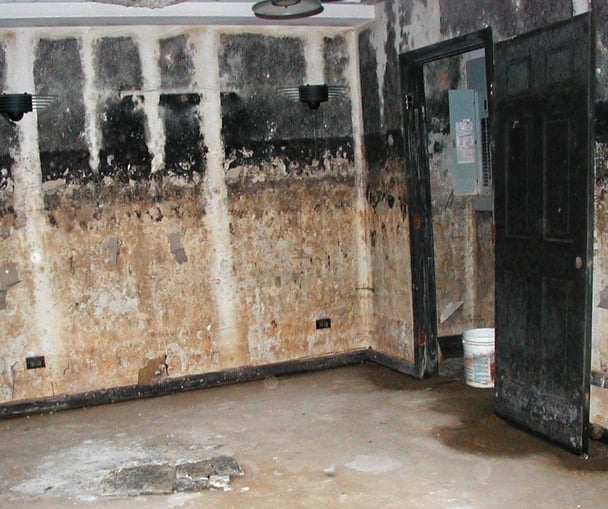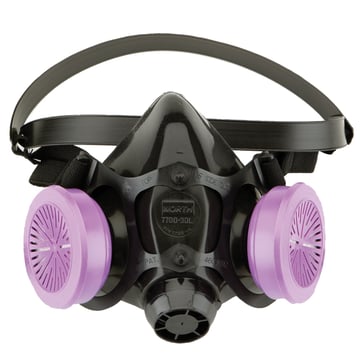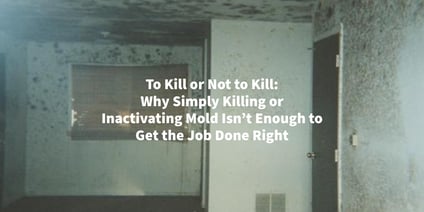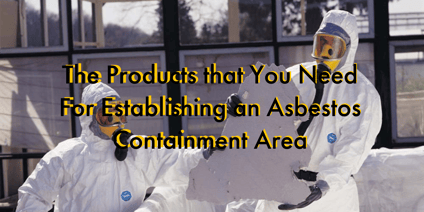Post 1 of 3 in our Mold Remediation Series
There’s no doubt you have heard phrases such as “toxic mold” or even “killer mold”. But you also may have heard of sayings like, “mold is gold.”
From the small leak originating from a water line inside a wall to tropical storms like Laura, some mold remediation companies are staying busy with mold remediation work. Others have been forced into performing mold remediation due to customer requests as well as a decline in work during a pandemic.
Regardless of the reasons why contractors enter into the mold remediation industry, protecting workers against mold exposure is critical.
Who are the high-risk populations? What precautions need to be taken and procedures followed to avoid potentially harmful exposures to technicians and occupants? What level of mold is considered “safe” or “normal”?
I’ll explore the answer to these questions below.

Mold Exposure
Understanding health and safety issues presented by mold must begin with the realization that mold is ubiquitous which means that it is naturally occurring everywhere around us. We cannot avoid contact with mold spores or particles every day of our lives.
Relatively few of the more than 100,000 species of mold are either pathogenic (capable of producing disease) or toxigenic (producing toxins that act as poisons in sufficient dosage). The goal in mold remediation is not to totally eliminate mold, but to reduce it to or below normal levels without the dominance of indicator molds.
Indicator molds are molds that commonly grow in a built environment due to elevated moisture such as with leaks, floods, or uncontrolled climate. The IICRC ANSI S520 defines “normal” as “Condition 1” which is defined as having mold types and counts consistent compared to an outdoor reference sample.
There are no published data from regulatory agencies that give “safe” or “acceptable” concentrations for mold inside of a built environment. There are many guidelines that have been published, but the information varies due to differences in climate, geographical locations, individual susceptibility, and opinions. Unfortunately, there are many opinions that are in disagreement, and little science to substantiate them.
The Possible Health Effects That You Want to Avoid
The most common symptoms individuals experience after being exposed to mold are allergies and hay fever.
Some species of mold can cause infection in humans such as ringworm, aspergillosis, or athlete’s foot. And yet, there are still some mold types that can produce mycotoxins which are a large group of toxins that certain molds produce to give them a competitive advantage in their environment. These same toxins can cause more severe reactions in certain individuals.
What Groups Are Considered High-Risk to Mold Exposure?
- Infants (Children under 2 years of age) because they have underdeveloped immune and respiratory systems. Their metabolism and respiratory rates are much faster than adults. They breathe 2 -3 times faster than that of an adult which means they are being exposed to higher concentrations of mold in comparison. They are also much smaller in size.
- Pregnant women, especially in the first trimester. The most important components of the fetus are being developed during this stage such as the heart, lungs, and brain. Exposure to certain fungal toxins and chemicals can have a negative effect on the unborn fetus.
- The Elderly (Over 65 years of age). As we age, immune systems weaken which makes older individuals more susceptible to acquiring illness or complications that a younger, stronger immune system would be able to provide protection against. Many times, older individuals may be taking medications that also create a risk to exposure such as those commonly used to treat rheumatoid arthritis.
- The immune-compromised will always be at higher risk for many types of exposures. Individuals diagnosed with HIV, Hepatitis, cancer, or immune deficiencies are more likely to develop complications.
Even healthy individuals can become sensitized and develop allergies with prolonged exposure to mold. For this reason, it is extremely important that individuals remediating mold and frequently have high exposure to it must be provided the proper personal protective equipment and use proper engineering controls to prevent exposure, (See here and here).
The Seven Most Common Mistakes That Contractors Make When Dealing With Mold
What are the common mistakes made during mold remediation projects?
The following reminders will be helpful, both to experienced mold workers who may occasionally become complacent, as well as by technicians who are trained in water damage restoration but have limited training or experience in mold remediation.
-
Disturbing and Spreading Mold Spores and Fragments By the Use of Air Movement
Air movers are standard equipment used during a water loss job, but they usually should not be used when mold is present until containment has been set up and pressure differentials established to prevent mold from spreading to uncontaminated areas.

-
Insufficient (or no) Respiratory Protection
A NIOSH (National Institute for Occupational Safety and Health) approved respirator MUST be used any time when working in areas with elevated levels of mold. An N95 respirator is the minimum acceptable standard. In many situations, a half-face or full-face respirator equipped with a HEPA (high-efficiency particulate air) filter may be recommended. When a disposable N95 or half-face respirator is used, eye protection is also needed. The respirator must seal to the face because Facial hair can prevent a tight seal. Medical evaluations are required by OSHA prior to respirator use and must be fit-tested to the technician. Restoration firms as well as the employees must be compliant with OSHA regulations for all personal protective equipment use. Always use a full- face cover, or half-face cover correctly.
-
Lack of Containment and Pressure Differentials
There is no wrong way to construct containment as long as it does what it is intended and prevents cross-contamination. When constructing containment, it needs to be strong enough to withstand the negative pressure that it is placed under and as well as the activities taking place inside.
It should also be constructed so that it looks professional because it is a direct reflection of the professionalism of the company that built it. If it is sloppy and looks like a third-grader built it, your customer will likely question how professional the services are that you are performing.
Containments MUST have an exit/decon chamber that serves as a transitionary space between the affected and unaffected areas. This provides workers space to decontaminate their PPE and equipment before bringing it outside of the containment. It also serves as an airlock to allow negative pressure to be maintained upon entry and exit.
A minimum negative pressure of -5 Pascals (-0.02 inches of water column) should be created and maintained during the remediation. This is sufficient to prevent contaminants from escaping the work area. It is also important that the HEPA air filtration or negative air machine that you use can achieve a minimum of four air changes per hour (ACH). Industrial hygiene practices recommend four to allow for proper ventilation and dilution of make-up air inside containment.

-
Lack of HEPA Filtration
It is standard practice to vacuum many mold-contaminated surfaces using a HEPA vacuum. Not every vacuum that says “HEPA” somewhere on the packaging provides true HEPA filtration because the vacuum may have a HEPA filter while allowing air, along with mold, to exit the vacuum without passing through the filter. It is critical to use a HEPA vacuum specifically designed for this use.
You must be careful that the filter is properly seated so that all air must pass through the filter. After use, the filter and the contents of the vacuum should be disposed of in heavy plastic bags, often double-bagged. This ensures mold is not spread to unaffected areas.
-
Improper Use of Protective Suits
There are three potential issues here. First, a protective suit should be sealed at the wrists and ankles. Otherwise, mold which can be a skin irritant can contact exposed skin. The proper procedure for removing protective clothing (doffing) should be followed. Failure to do so may result in either the technician or areas outside the containment becoming contaminated by mold on the exterior of the suit.
Always remember that disposable coveralls have different protection factors assigned to them by the specific manufacturer. Some are more permeable than others which means they are more breathable.
Depending on the task, the worker should choose a suit designed for the hazards that you will face on the job. For example, if a technician is working in a wet crawl space, they do not want a suit that does not have sealed seams or is not moisture resistant. If a technician is performing mold remediation, they may choose to wear a suit that still holds out 100% of dry particulate but is still breathable to allow for body heat to escape.
Technicians working in hot, humid conditions will need frequent breaks for rest and rehydration. Be aware of OSHA regulations regarding working in hot areas. Heat exhaustion and stroke are common risks for employees working under these conditions. OSHA does not regulate or provide required times for breaks as it is dependent on the heat tolerance of each individual, (See here and here).
-
Eating, Drinking, Use of Cosmetics or Tobacco Where Mold Remediation is Being Performed
This may result in unnecessary contamination with mold or other harmful substances in the work area.
-
Improper Use of Biocides and Bleach
Biocides may be toxic to humans and animals, as well as to mold. The preferred remedy is to remove the mold and return the structure and contents to a clean and dry condition.
The use of biocides does not replace cleaning and source removal. They should be used as a tool to achieve the removal of mold contamination and MUST be used consistently with the manufacturer's label instructions. Ensure technicians are wearing the appropriate PPE as stated on the label or safety data sheet (SDS) and are NOT used in a manner that could result in aerosolizing contamination or other debris, (See here and here).
Conclusion
With proper training, the right PPE, and workplace safety measures, mold remediation can be a profitable and — most importantly — a safe pursuit.
Rachel Adams-Beja has more than 30 years of experience in microbial remediation and industrial hygiene. She serves as a Corporate Account Manager for Aramsco and as the AMRT TAC Chair for the IICRC AMRT course as well as a consensus body member for IICRC Standards including S500, S520, S530. She can be contacted at radams@aramsco.com.
Enjoyed reading this post? Read the following articles:
References:
- About 1,000 species of mold have been identified in the USA. OSHA A Brief Guide to Mold in the Workplace.
- IICRC ANSI S520 and R520, current version
- ACGIH: Bioaeresols: Assessment and Control
- S. Centers for Disease Control (CDC) How do Molds Affect People?
- Certified Mold & Allergen Free Corp, 2008
- OSHA, 29CFR1910.134 and .156(b)
Take your education beyond our blogs:
Aramsco/ Interlink Supply Training Schedule (cvent.com)
IIRC Applied Microbial Remediation Tech



